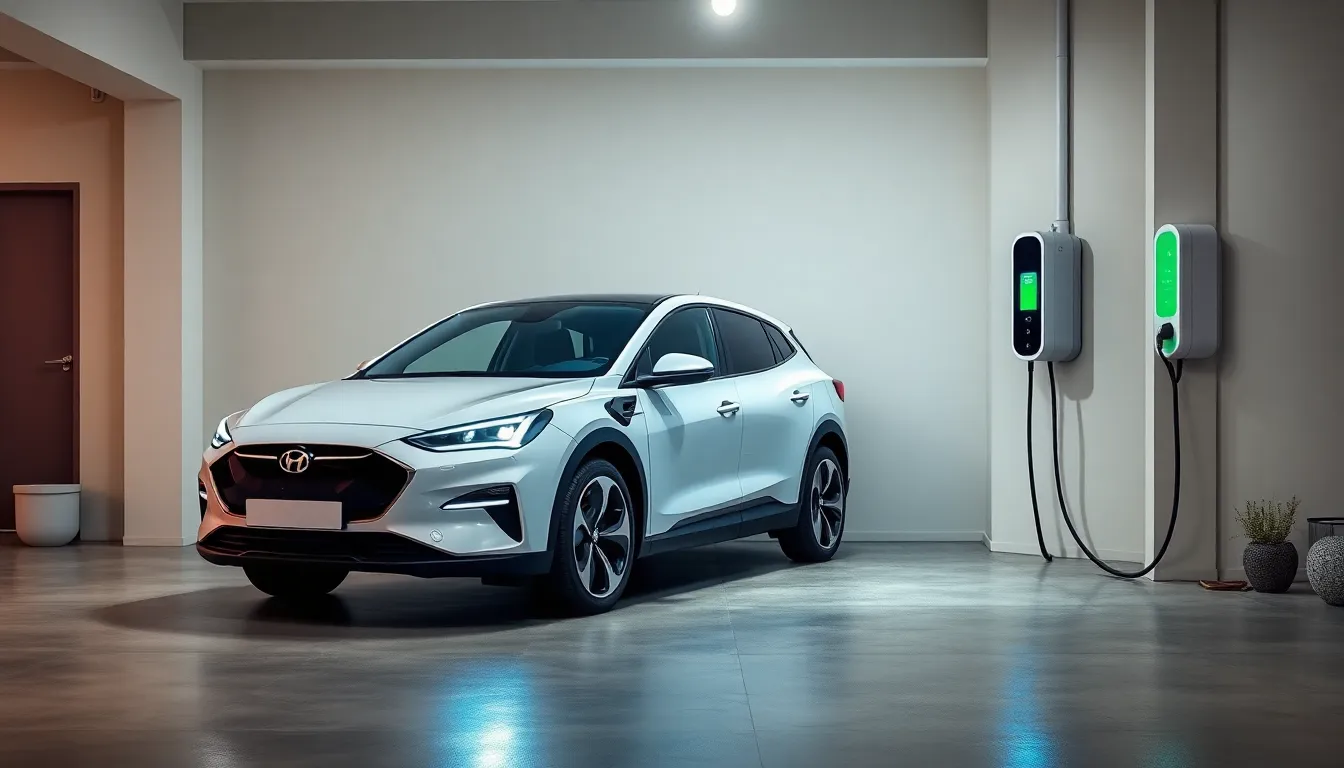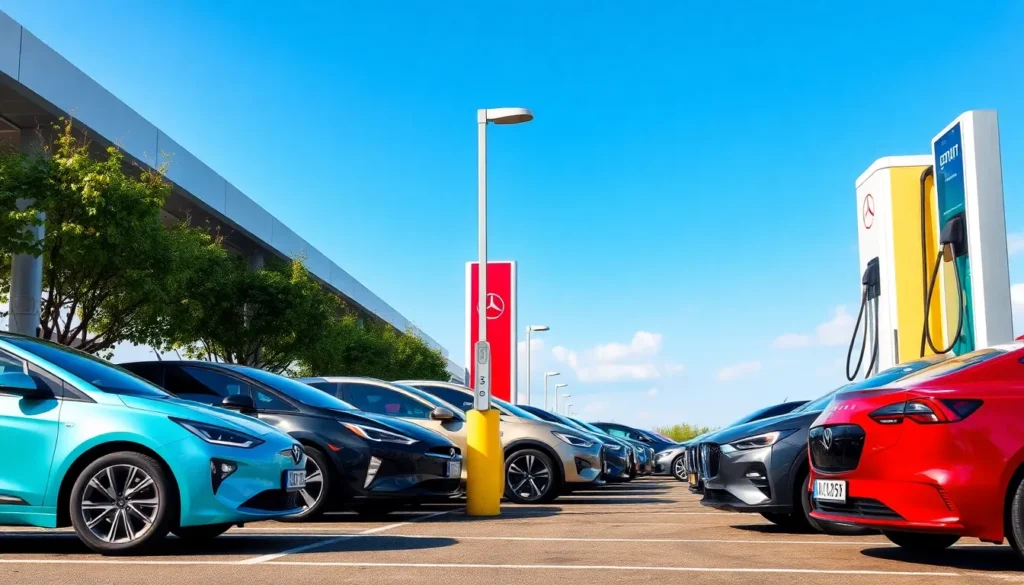As electric vehicles zoom into the mainstream, a common question pops up faster than a Tesla at a stoplight: do all electric vehicles use the same charger? Picture this: you’re at a charging station, your EV is running low, and you’re faced with a wall of chargers that look like a game of Tetris gone wrong. It’s enough to make anyone’s head spin!
Table of Contents
ToggleOverview of Electric Vehicle Charging
Electric vehicle charging involves multiple types of connectors and charging standards, leading to variations across different EV models. Most common types include Level 1, Level 2, and DC fast charging. Level 1 charging uses a standard household outlet, optimal for overnight charging with lower power output.
Level 2 chargers provide faster charging and suit home and public stations, requiring a dedicated circuit. These chargers deliver approximately 240 volts, significantly reducing charging time compared to Level 1.
DC fast chargers operate at higher voltages, often above 400 volts, allowing substantial charging in short durations. These chargers are typically found at public charging stations, making long-distance travel more manageable for EV drivers.
Connector types also differ, with the most widely used standards being CCS (Combined Charging System) and CHAdeMO for DC fast charging. Tesla vehicles utilize a proprietary connector but offer adapters for compatibility with other charging standards.
Regional differences also influence the types of chargers available. Europe tends to favor the CCS connector, while North America features a mix of connectors like J1772 for Level 2 charging.
Multiple charging types and connectors exist across electric vehicles. Understanding these differences facilitates better navigation of charging networks and enhances the electric vehicle ownership experience.
Types of Electric Vehicle Chargers

Electric vehicle chargers fall into three main categories. Each type serves distinct purposes and offers varying charging speeds.
Level 1 Chargers
Level 1 chargers connect directly to standard household outlets. These chargers typically provide 120 volts. He or she can expect a charging rate of about 4 to 5 miles of range per hour. Using a Level 1 charger is convenient for overnight home charging. However, it may not suffice for daily driving needs in households with multiple electric vehicles.
Level 2 Chargers
Level 2 chargers operate on a 240-volt system. Charging rates increase significantly, delivering approximately 25 to 30 miles of range per hour. They require a dedicated circuit, often installed in homes or public charging stations. Charging an electric vehicle with Level 2 enhances convenience for daily commutes. Many commercial locations now feature these chargers due to their efficiency.
DC Fast Chargers
DC fast chargers provide rapid charging at high voltages, typically exceeding 400 volts. These chargers can recharge an electric vehicle to 80 percent capacity in about 20 to 30 minutes. Fast charging stations often appear on highways, making long trips more feasible. He or she should note that not all electric vehicles are compatible with every DC fast charger. Understanding charging options ensures a smoother journey for electric vehicle owners.
Compatibility Among Different Electric Vehicle Brands
Compatibility among electric vehicle brands varies significantly due to different charging standards and protocols. This disparity plays a crucial role in the charging experience.
Charging Standards and Protocols
Multiple charging standards exist for electric vehicles, creating a complex landscape. CCS (Combined Charging System) serves as the predominant fast charging standard in Europe and North America. Public stations often employ this standard for DC fast charging, enabling efficient replenishing of vehicles. Similarly, CHAdeMO, popular among certain manufacturers, provides another standard, particularly for Japanese brands. Additionally, Tesla uses its proprietary connector, allowing access primarily to its own vehicles. This diversity in standards necessitates awareness from EV owners to ensure compatibility at charging stations.
Major Electric Vehicle Manufacturers
Major electric vehicle manufacturers adopt varied charging systems to meet market demands. Tesla consistently utilizes its exclusive connector, ensuring only its vehicles are compatible with its charging network. General Motors favors J1772 for Level 2 charging, which caters to a range of models. Nissan and Mitsubishi primarily utilize CHAdeMO and align with its established protocol. Ford and Volkswagen increasingly embrace CCS for fast charging across their electric lineups. This evolution highlights how manufacturers navigate the charging infrastructure landscape, reinforcing the importance of knowing compatibility before embarking on electric vehicle journeys.
Factors Influencing Charger Compatibility
Charger compatibility for electric vehicles depends on several critical factors. These include connector types and charging speed variations.
Connector Types
Multiple connector types exist, impacting charging compatibility across electric vehicles. CCS stands for Combined Charging System, commonly utilized in Europe and North America for fast charging. CHAdeMO, another prevalent connector, is especially favored by some Japanese manufacturers. Tesla’s proprietary connector, exclusive to its vehicles, also plays a significant role in compatibility challenges. The J1772 connector serves well for Level 2 charging, standard across many brands. Differences across regions further complicate the issue, as various markets adopt specific standards. Understanding these connector types ensures better navigation of charging stations.
Charging Speed Variations
Charging speed significantly affects the EV ownership experience. Level 1 charging provides approximately 4 to 5 miles of range per hour, making it suitable for overnight charging at home. Level 2 charging, however, delivers 25 to 30 miles of range per hour, commonly found in residential setups and public stations. DC fast charging takes the lead, offering rapid refills by reaching 80 percent charge in about 20 to 30 minutes at public stations. Different electric vehicle brands may employ varied charging technologies, influencing the speed and efficiency of recharging. Prioritizing compatibility based on charging speed aids in maximizing the electric vehicle experience.
Electric vehicle charging isn’t a one-size-fits-all scenario. With various types of chargers and connectors available it’s essential for EV owners to understand their specific vehicle’s requirements. The differences in charging standards like CCS and CHAdeMO can lead to confusion but also highlight the evolving landscape of electric vehicle technology.
As the market grows and more manufacturers enter the scene, compatibility will continue to be a focal point. Staying informed about charging options can enhance the EV ownership experience and ensure that drivers can charge their vehicles efficiently. Embracing this knowledge will pave the way for smoother journeys and greater confidence in navigating the electric vehicle charging infrastructure.





